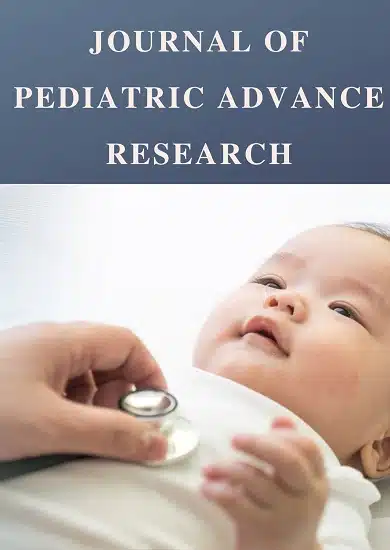Research Article | Vol. 4, Issue 1 | Journal of Pediatric Advance Research | Open Access |
Study Relation between Female Workers’ History and Their Knowledge About Breast Cancer, Breast-Self-Examination and Preventive Measures
Fatma Saber Nady1, Sahar Gamal Zaki2, Hanan Elzeblawy Hassan3*
1Lecturer of Maternal and Newborn Health Nursing, Faculty of Nursing, Beni-Suef University, Egypt
2Demonstrator of Maternal and Newborn Health Nursing, Faculty of Nursing, Beni-Suef University, Egypt
3Professor of Maternal and Newborn Health Nursing, Faculty of Nursing, Beni-Suef University, Egypt
*Corresponding author: Hanan Elzeblawy Hassan, Professor of Maternal and Newborn Health Nursing, Faculty of Nursing, Beni-Suef University, Egypt; Email: [email protected]
Citation: Nady FS, et al. Study Relation between Female Workers’ History and Their Knowledge About Breast Cancer, Breast-Self-Examination and Preventive Measures. J Pediatric Adv Res. 2025;4(1):1-9.
Copyright© 2025 by Nady FS, et al. All rights reserved. This is an open access article distributed under the terms of the Creative Commons Attribution License, which permits unrestricted use, distribution, and reproduction in any medium, provided the original author and source are credited.
| Received 10 January, 2025 | Accepted 07 February, 2025 | Published 15 February, 2025 |
Abstract
Background: Breast cancer incidence is significantly higher in patients with a family history, attributed to epigenetic modifications and environmental triggers, regardless of age. Aim: study relation between female workers’ history and their knowledge about breast cancer, breast-self-examination and preventive measures.
Subjects and Methods: A study of 323 Beni-Suef University working women was conducted, focusing on various faculties, from December 2023 to May 2024. Tools: Tool I: A structured interviewing questionnaire sheet and Tool II: women’s knowledge about breast cancer, breast self-examination and breast cancer preventive measures.
Results: 70.0% of females do not have breast problems, 33.0% have discharge issues, 48.3% of them were unaware of how to perform breast self-examination and 74.9% of them did not practice it. Moreover, 73.1% didn’t have a family history of breast cancer and 44.9% get information about breast cancer from social media. Regarding total knowledge level about breast cancer, breast self-examination and breast cancer preventive measures (71.80%, 24.2%, 4%) with the following levels: poor, average and good, respectively.
Conclusion: Based on the findings of the present study, it can be concluded that no statistically significant relation between family history of breast cancer, having a mammogram and history of breast problems of the studied female workers and their total knowledge about breast cancer, breast self-examination and breast cancer preventive measures.
Recommendations: Spot that medical knowledge should be taken from medical specialist not from social media.
Keywords: Study; Relation; Female Workers; Knowledge; Breast Cancer; Breast-Self-Examination
Introduction
The most common malignancy in women is Breast Cancer (BC) and the fatality rate from BC is rising daily. In addition, 19.3 million new cases of cancer are predicted to be diagnosed in 2025 due to the aging population and more than half of cancer-related fatalities are anticipated to occur in less developed countries worldwide [1]. Higher fatality rates and higher health costs are associated with increased BC incidence [2-6]. On the other hand, one of the most crucial elements in evaluating the results of diagnosis and therapy is continuing an efficient cancer screening program [7-10]. Because of this, early diagnosis and screening programs should be used to control and prevent BC. Breast Self-Examination (BSE), Clinical Breast Examination (CBE) and mammography are essential for the early identification of breast cancer [11-16].
In the past, lobular Carcinoma In Situ (LCIS), commonly referred to as lobular neoplasia and Ductal Carcinoma In Situ (DCIS) were thought to be the two primary forms of in situ breast cancer. However, LCIS was eliminated from the most recent version of the American Joint Committee on Cancer (AJCC) breast cancer staging system since it is generally thought to be a benign condition linked to an increased risk of breast cancer but without the potential to proceed to invasive malignancy. On the other hand, while not every DCIS advances, it is a sign of invasive malignancy [18-24].
Breast cancer is a disease that originates from the breast and emerges mostly from the epithelial cells lining the milk ducts. Although carcinomas are cancerous by definition, benign tumors of the breast contained inside the basement membrane are described as Ductal Carcinoma In Situ (DCIS) and Lobular Carcinoma In Situ (LCIS) [25-32].
Aim of the Study
The current study was conducted to study relation between female workers history and their knowledge about breast cancer, breast-self-examination and preventive measures.
Subject and Method
Subjects and Settings
A study of 323 Beni-Suef University working women was conducted, focusing on various faculties, from December 2023 to May 2024.
Tools of Data Collection
Tool I: A Structured Interviewing Questionnaire Sheet
It was developed by the researcher based on the review of relevant literature. It aimed to gather information related to women and consisted of parts as family history of breast cancer; if yes, mention the relationship, history of breast problems and types of problem, breast self-examination practice. Besides asking them where they got their information about breast cancer from.
Tool II: women’s knowledge about breast cancer, breast self-examination and breast cancer preventive measures.
Closed-ended questions were used to gauge the women’s awareness of breast cancer, breast self-examination and breast cancer prevention strategies. A total score of 55 degrees was awarded for all questions, with one point awarded for a correct response and zero points for an erroneous one. The overall knowledge score distribution is categorized as follows: Average: for scores between 50% and 74%, Good: for scores of ≥75% and ≥ 40 degrees. Poor: for scores below 50% and below 27 degrees and (27–40) degrees.
Tools Validity and Reliability
A panel of five experts from Beni-Suef University assessed the study instruments’ content validity and the Cronbach’s Alpha test was used to gauge their reliability in order to guarantee consistent outcomes over time.
Ethical Consideration
The study received ethical approval from Beni-Suef University’s Faculty of Medicine’s Research Ethics Committee.
Pilot Study
32 women or 10% of the total study population, participated in a pilot study to evaluate the tools’ efficacy, usability and comprehensibility.
Statistical Design
The updated, coded and computer-entered data were statistically analyzed using the Statistical Package for Social Science (SPSS) version 20. P-values ≤0.05 are statistically significant, p-values ≤0.001 are extremely significant and p-values >0.05 are insignificant. The data were displayed in tables using number, percentage distribution and square.
Results
Fig. 1 shows that 70.0% of females do not have breast problems, 33.0% have discharge issues and 59.8% have not undergone special investigation or medical breast examination. As shown in Fig. 2, 50.5% of them were aware that the first step in the early detection of breast cancer was breast self-examination. Furthermore, 48.3% of them were unaware of how to perform breast self-examination and 74.9% of them did not practice it. Fig. 3 presents the percentage distribution of the studied female workers regarding their family history of breast cancer. It reveals that 73.1% of the studied female workers didn’t have a family history of breast cancer, while females who had a family history of breast cancer with first-degree relatives (mothers) were 40.0%.
Fig. 4 shows sources of information about breast cancer and illustrates that (44.9%) of females get information about breast cancer from social media. Fig. 5 illustrates female workers’ regarding their total knowledge level about breast cancer, breast self-examination and breast cancer preventive measures, were (71.80%, 24.2%, 4%) with the following levels: poor, average and good, respectively.
Table 1 shows that there was no statistically significant relation between family history of breast cancer, having a mammogram and history of breast problems of the studied female workers and their total knowledge about breast cancer, breast self-examination and breast cancer preventive measures. Table 2 shows that 25.4% of the studied female workers who got their information about breast cancer from social media had poor knowledge. There is a highly statistically significant relation between sources of information and their total knowledge (P-value = 0.000).
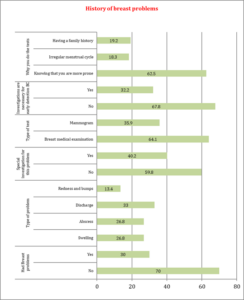
Figure 1: History of breast problems of the studied female workers.
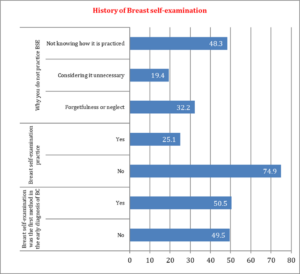
Figure 2: History of Breast self-examination of the studied female workers.
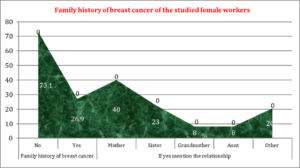
Figure 3: Percentage distribution of the studied female workers regarding their family history of breast cancer (n=323).
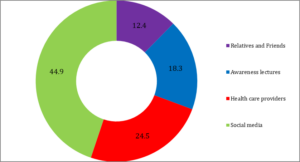
Figure 4: Sources of information about breast cancer.
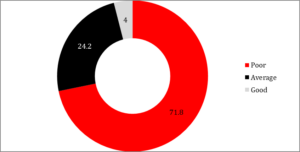
Figure 5: Percentage distribution of the studied female workers’ regarding to their total knowledge level about breast cancer, breast self-examination and breast cancer preventive measures.
Items | No. | Poor (n=232) | Average (n=78) | Good (n=13) | X2 (p value) |
% | % | % | |||
Family history of BC |
|
|
|
|
|
No | 236 | 51.4 | 18.3 | 3.4 | 1.414 (0.493) |
Yes | 87 | 20.4 | 5.9 | 0.6 | |
Had a mammogram |
|
|
|
|
|
No | 302 | 66.3 | 23.5 | 3.7 | 2.623 (0.269) |
Yes | 21 | 5.6 | 0.6 | 0.3 | |
Had breast problems |
|
|
|
|
|
No | 226 | 50.7 | 15.8 | 3.4 | 2.165 (0.339) |
Yes | 97 | 21.1 | 8.4 | 0.6 | |
* Statistically significant at p≤0.05 ** Highly statistical significant at p≤0.01 | |||||
Table 1: Relation between history of the studied female workers and their total knowledge about breast cancer, breast self –examination and breast cancer preventive measures (n=323).
Items | Poor (n=232) | Average (n=78) | Good (n=13) | X2 (p value) | ||||
No. | No. | % | No. | % | No. | % | ||
Relatives and Friends | 40 | 36 | 11.1 | 3 | 0.9 | 1 | 0.3 | 32.872 (0.000**) |
Awareness lectures | 59 | 51 | 15.8 | 7 | 2.3 | 1 | 0.3 | |
Health care providers | 79 | 63 | 19.5 | 15 | 4.6 | 1 | 0.3 | |
Social media | 145 | 82 | 25.4 | 53 | 16.4 | 10 | 3.1 | |
* Statistically significant at p≤0.05 ** Highly statistical significant at p≤0.01 | ||||||||
Table 2: Relation between sources of information of the studied Female workers and their total knowledge about breast cancer, breast self-examination and breast cancer preventive measures (n=323).
Discussion
Breast cancer incidence is significantly higher in patients with a family history, attributed to epigenetic modifications and environmental triggers, regardless of age [33-37]. The aim of the study was study relation between female workers’ history and their knowledge about breast cancer, breast-self-examination and preventive measures.
The study analyzed the socio-demographic characteristics of female workers, revealing that over half were aged 30-40 years, with a mean age of 35.91±7.122 years. This is in line with previous study of Mahmoud, et al., [38]. The study also found that less than half of the female workers had university education, which is consistent with previous studies. The majority of the female workers were married and urban residents, which is consistent with previous studies. The study also found that the majority of female workers had sufficient monthly income, which differs from Abd-Elaziz, et al., who found that only one-fifth of the participants had sufficient income. These disparities may be due to different community socio-economic levels [39].
The study found that around three-quarters of female workers do not have a family history of breast cancer, consistent with previous research [40,41]. However, a minority of participants had a family history of cancer. The study also found that two-fifths of adolescent Omani school students in Oman had a family history of breast cancer [42]. Interestingly, less than half of females had a family history of breast cancer with consanguinity, contradicting previous studies [43,44].
In relation to family history of breast cancer, the current study proved that around three-quarters of the studied female workers didn’t have a family history of breast cancer. This finding was contradicted by Al-Hosni, et al., who found, in their study, that two-fifths of the participating women had a family history of breast cancer [42]. Regarding females who had a family history of breast cancer with consanguinity, they were less than one-half. This finding parallels Mohamed, et al., who studied “knowledge of high school female students about breast self-examination” and showed that less than half had a first-degree relative with cancer [43].
The study reveals that less than half of female workers receive breast cancer information from social media, despite increased internet use. The study found a significant relationship between information sources and total knowledge about breast cancer, self-examination and preventive measures. This finding is not in line with Parsa, et al., who found no significant association between information sources and breast cancer knowledge among female teachers in Selangor, Malaysia [45].
The study found that most female workers have poor knowledge about breast cancer, self-examination and preventive measures, consistent with Elbasuony, et al., findings [46]. The study investigates the correlation between the family history of breast cancer among female workers and their overall knowledge about breast cancer, self-examination and preventive measures. The results indicated that poor knowledge were more prevalent among did not previously have family history of breast cancer, did not had mammogram and did not have breast problems. This may be indicated that past history lead to search and increase, women’s knowledge.
The study found no significant correlation between family history of breast cancer and female workers’ total knowledge about breast cancer, self-examination and preventive measures. This finding agreed with Al-Mousa, et al., but conversely different from Subramanian, et al., [47]. The study found a significant relationship between sources of information and female workers’ knowledge about breast cancer, self-examination and preventive measures. Social media information improved knowledge before the program, but not after the educational program. Parsa, et al., found no significant association between information sources and breast cancer knowledge among female teachers in Selangor, Malaysia [47].
Limitation of the Study
Study sample sometimes were busy to cooperate and follow up that take more time to finish the study.
Conclusion
Based on the findings of the present study, it can be concluded that no statistically significant relation between family history of breast cancer, having a mammogram and history of breast problems of the studied female workers and their total knowledge about breast cancer, breast self-examination and breast cancer preventive measures. Social media consider the source of information for female workers.
Recommendation
- Spot that medical knowledge should be taken from medical specialist not from social media
- Create an educational program to raise women’s knowledge of breast cancer and prevention strategies
- As most of the studied women did not practice breast self-examination because they did not know its steps; this highlight need for an educational program
Conflict of Interests
The authors have no conflict of interest to declare.
References
- Akarsu NK, Andsoy II. Evaluation of breast self-examination training in Turkish women living in Northwestern Turkey. J Preventive Medicine and Hygiene. 2022;63(1):E76.
- Mohammed F, Shahin M, Youness E, Hassan H. Survivorship in women undergoing gynecological and breast cancer treatment in upper Egypt: the impact of quality of life improvement educational program. Am Res J Gynaecol. 2018;2(1):1-28.
- Nady F, Said M, Youness E, Hassan H. Impact of tailored educational program of quality of life improvement on women undergoing breast cancer treatment at El-Minia region, Egypt. Am Res J Gynaecol. 2017;1(1):1-7.
- Qalawa S, Eldeeb A, Hassan H. Young Adult Women’s intention regarding breast and cervical cancer screening in Beni-Suef. Scientific Research Journal. 2015;3(3):11-24.
- Hassan H, Bayoumi M, Atwa A. Emotional distress associated with gynecologic and breast cancer in Beni-Suef city. Int J Sci and Res. 2016;5(2):1118-29.
- Said S, Hassan H, Sarhan A. Effect of an educational intervention on women’s knowledge and attitude regarding cervical cancer. American Journal of Nursing Res. 2018;6(2):59-66.
- Nady FS, Youness EM, Hassan H. Effect of nursing intervention program on quality of life improvement for women undergoing gynecological and breast cancer treatment. Assiut Scientific Nursing J. 2018;6(15):62-77.
- Gamal Zaki Mohamed S, Saber Nady F, Elzeblawy Hassan H. Breast cancer preventive measures among female workers at Beni-Suef University: Educational program based on health belief model. Egyptian J Health Care. 2025;16(1):117-42.
- Hassan HE. Early stage cervical cancer: survivorship and fertility preservation. Am Res J Oncol. 2020;2(1):1-3.
- Mohamed A, Hassan H, Gamel W, Arafa A. Awareness about breast and cervical cancers among nursing students in Beni-Suef University. J Nursing Education and Practice. 2019;9(5):44-51.
- Zagloul MC, Hassan HE, Naser EG. Cervical cancer knowledge, attitude and practices: educational program management for female workers at Port Said University. Int J Studies in Nursing. 2020;5(3):1.
- Abd El Salam S, Hassan HE, Hagar Kamal RA. Women’s sexual dysfunction associated with cervical cancer. Journal of Applied Health Sciences and Medicine. 2021;1(2):12-27.
- Hassan HE, Masaud H, Mohammed R, Ramadan S. Self-knowledge and body image among cervical cancer survivors women in northern upper Egypt. J Applied Health Sciences and Medicine. 2021;1(1):1-2.
- Hassan HE. Women with cervical cancer: Impact of an educational program their knowledge. J. Obstetrics Gynecology and Reproductive Sciences. 2021;5(2).
- Masaud H, Hassan H, Mohammed R, Ramadan S. Women’s sexual distress associated with cervical cancer. Sumerianz J Medical and Healthcare. 2021;4(1):28-34.
- Elzeblawy H, Kamal H, Abd El-Salam S, Ali R. Survivors from cervical cancer: impact of an educational program on self-knowledge and body-image. Public Health Open Acc. 2021;5(2):1-9.
- Hassan H, Ali R, Abd El Salam S, Kamal H. Impact of an educational program on sexual dysfunction associated with cervical cancer. J Cancer Research and Treatment, 2021;9(2):22-31.
- Hassan H, Ramadan S, Ali R, Kamal H. Sexual issues among cervical cancer survivors’ women in northern upper Egypt. J Advanced Trends in Basic and Applied Science, 2021;1(1):1-11.
- Sokolova A, Lakhani SR. Lobular carcinoma in situ: Diagnostic criteria and molecular correlates. Modern Pathology. 2021;34:8-14.
- Abd El Salam, Ali R, Hassan H, Kamal H. Outcome of an educational program on body image distress associated with cervical cancer. J Advanced Trends in Basic and Applied Science. 2021;1(1):12-20.
- Kamal Masaud H, Ali Mohammed R, Abd El Salam Ramadan S, Elzeblawy Hassan H. Impact of protocol of nursing intervention on sexual dysfunction among women with cervical cancer. J Nursing Science Benha University. 2021;2(2):203-24.
- Hassan H, Mohammed R, Ramadan S, Masaud H. Impact of an educational program on sexual issues among cervical cancer survivors’ women in Northern Upper Egypt. J Obstetrics Gynecology and Reproductive Sciences. 2021;5(1):1-16.
- Ali R. Impact of an educational program on sexual distress associated with cervical cancer. J Applied Health Sciences and Medicine. 2021;1(1):30-42.
- Testa U, Castelli G, Pelosi E. Breast cancer: A molecularly heterogenous disease needing subtype-specific treatments. Medical Sciences. 2020;8(1):18.
- Farag D, Mohamed S, Malk R, Hassan H. Effectiveness of educational intervention program about cervical cancer on working women’s knowledge, attitude and practice at Beni-Suef University. Egyptian J Health Care. 2024;15(1):1-16.
- Nady FS, Zahran KM, Youness EM, Hassan HE. Women’s knowledge and perception about benefits of folic acid intake before and during pregnancy according to health belief model in Beni-Suief City. Assiut Scientific Nursing J. 2014;2(3):43-55.
- Gamal Zaki Mohamed S, Saber Nady F, Elzeblawy Hassan H. Breast Cancer Preventive Measures among Female Workers at Beni-Suef University: Educational Program Based on Health Belief Model. Egyptian J Health Care. 2025;16(1):117-42.
- Hassan H, Zaki S, Nady F. Female workers’ socio-demographic characteristics and their total knowledge about breast cancer: Effect of an educational program at Beni-Suef University. Int J Nursing Sci. 2025;15(1).
- Hassan HE. Women’s body image distress associated with cervical cancer J. Obstetrics Gynecology and Reproductive Sciences. 2021;5(3):1-6.
- Hagar Kamal RA, Abd El Salam S, Hassan HE. Self-knowledge among women with cervical cancer. J Cancer Res. 2021;9(1):12-21.
- Hassan H, Zaki S, Nady F. Effect of an educational program on female workers’ knowledge about breast cancer preventive measures at Beni-Suef University. Am J Nursing Research. 2025;13(1):1-10.
- Behravan H, Hartikainen JM, Tengström M, Kosma VM, Mannermaa A. Predicting breast cancer risk using interacting genetic and demographic factors and machine learning. Scientific Reports. 2020;10(1):11044.
- Mahmoud AA, Abosree TH, Abd El Aliem RS. Effect of the health belief model-based education on preventive behaviors of breast cancer. Evidence-Based Nursing Research. 2020;2(4):11.
- Hassan H., Zaki S., Nady F. Female Workers’ Socio-demographic characteristics and Their Total Knowledge about Breast Cancer: Effect of an Educational program at Beni-Suef University. Int J Nursing Sci. 2025;15(1):1-8.
- Nady F, Zaki S, Hassan H. Female workers’ knowledge about breast cancer preventive measures at Beni-Suef University. Nursing and Care Open Access Journal. 2025;11(1):16-20.
- Zaki S., Hassan H., Nady F. Female workers’ knowledge about breast cancer at Beni-Suef University: Effect socio-demographic characteristics. Am J Public Health Research, 2025;13(1)
- Hassan H., Nady F., Zaki S. Northern upper Egyptian female workers’ beliefs regarding breast cancer according to health belief model: Effect of an educational program. Public Health Open Access. 2025;9(1):1-12.
- Abd-Elaziz NM, Kamal HH, Abd-Elhady H. Effect of breast self-examination programme on women’s awareness for early detection of breast cancer. Minia Scientific Nursing J. 2021;10(1):132-40.
- Elsawy MM, Mohamed HS, Mousa KM. Effect of utilizing health belief model on knowledge, beliefs and behaviour of visually impaired women toward breast self-examination. The Open Nursing J. 2023;17(1).
- Khalili A, Shahnaz M, Vahed L, Javadi L. Status of breast self-examination performance among women referring to Health Centers of Tabriz. Iran Crescent J Medical and Biological Sci. 2014;1(3):90-96.
- Al-Hosni K, Chan MF, Al-Azri M. Effectiveness of an Educational Program on awareness of breast Cancer risk factors, symptoms and barriers to seeking medical help among adolescent Omani School Students-An interventional study. Current Oncology. 2023;30(4):4126-38.
- Mohamed SE, Majashi AA, Ozran SA, Jeli SM. Knowledge of high school female students about breast self-examination: Educ Res Rev J. 2023;18(2):17-22.
- Shubayr N, Khmees R, Alyami A, Majrashi N, Alomairy N, Abdelwahab S. Knowledge and factors associated with breast cancer self-screening intention among Saudi female college students: utilization of the health belief model. Int J Environmental Research and Public Health. 2022;19(20):13615.
- Parsa P, Kandiah M, Zulkefli NM, Rahman HA. Knowledge and behavior regarding breast cancer screening among female teachers in Selangor, Malaysia. Asian Pacific J Cancer Prevention. 2008;9(2):221-8.
- Elbasuony RA, Fadel EA, El-Nemer AM. Effect of a preventive breast cancer guideline on knowledge of healthy women with family history. 2020;7(3):553-66.
- Al-Mousa DS, Alakhras M, Hossain SZ, Al-Sa’di AG, Al Hasan M, Al-Hayek Y, et al. Knowledge, attitude and practice around breast cancer and mammography screening among Jordanian women. Breast Cancer: Targets and Therapy. 2020:231-42.
- Subramanian P, Oranye NO, Masri AM, Taib NA, Ahmad N. Breast cancer knowledge and screening behaviour among women with a positive family history: A cross sectional study. Asian Pacific J Cancer Prevention. 2013;14(11):6783-90.
Author Info
Fatma Saber Nady1, Sahar Gamal Zaki2, Hanan Elzeblawy Hassan3*
1Lecturer of Maternal and Newborn Health Nursing, Faculty of Nursing, Beni-Suef University, Egypt
2Demonstrator of Maternal and Newborn Health Nursing, Faculty of Nursing, Beni-Suef University, Egypt
3Professor of Maternal and Newborn Health Nursing, Faculty of Nursing, Beni-Suef University, Egypt
*Corresponding author: Hanan Elzeblawy Hassan, Professor of Maternal and Newborn Health Nursing, Faculty of Nursing, Beni-Suef University, Egypt; Email: [email protected]
Copyright
Fatma Saber Nady1, Sahar Gamal Zaki2, Hanan Elzeblawy Hassan3*
1Lecturer of Maternal and Newborn Health Nursing, Faculty of Nursing, Beni-Suef University, Egypt
2Demonstrator of Maternal and Newborn Health Nursing, Faculty of Nursing, Beni-Suef University, Egypt
3Professor of Maternal and Newborn Health Nursing, Faculty of Nursing, Beni-Suef University, Egypt
*Corresponding author: Hanan Elzeblawy Hassan, Professor of Maternal and Newborn Health Nursing, Faculty of Nursing, Beni-Suef University, Egypt; Email: [email protected]
Copyright© 2025 by Nady FS, et al. All rights reserved. This is an open access article distributed under the terms of the Creative Commons Attribution License, which permits unrestricted use, distribution, and reproduction in any medium, provided the original author and source are credited.
Citation
Citation: Nady FS, et al. Study Relation between Female Workers’ History and Their Knowledge About Breast Cancer, Breast-Self-Examination and Preventive Measures. J Pediatric Adv Res. 2025;4(1):1-9.

